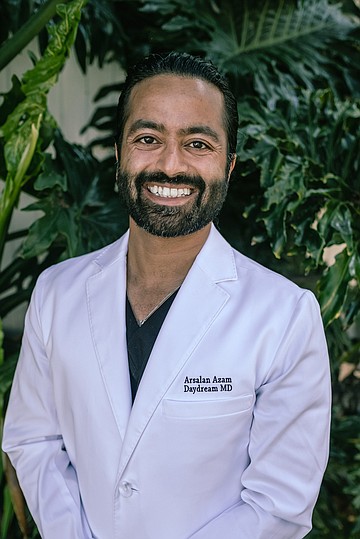 Facebook
Facebook
 X
X
 Instagram
Instagram
 TikTok
TikTok
 Youtube
Youtube

I could have interviewed Dr. Arsalan Azam about lots of different things. I could have asked for stories from his nearly 10 years of working in emergency medicine: delivering babies, assessing the schizophrenic and the suicidally depressed, working in a New York City hospital in which half of his patients were homeless people. I could have sought his opinions about problems in the world of medicine: the way that hospital staffing is mismanaged by greedy agencies, the way that mainstream psychiatry has brought “no real medication innovation in 50 years” due to inadequate drug-development funding. (He says that generally, when practicing medicine in the profit-centered system we all live with, “even if it is terribly obvious how you can improve things, there’s no way to get paid for that improvement.”)

But instead, I am asking about his vision; specifically, the one with ketamine at its heart. Azam knows ketamine well enough to be “extremely comfortable with it as a drug. It is one of the world’s most widely used anesthetics. It’s on the WHO list of essential medications; it’s generic, it’s cheap, it’s widely available, it’s shelf stable at room temperature, and it’s used in probably every country in the world.” As an emergency medicine doctor, he has used it on patients hundreds, if not thousands of times. But now, he and many others are finding out it also has exciting properties as a psychotropic drug.
As some readers may know, ketamine has been in the news of late not for its anesthestic qualities, but for its effect on mental pain. Ketamine is now a psychiatric medication. The drug’s mental health applications have won ketamine enthusiastic support both from mental health professionals and patients struggling with a variety of issues: most notably persistent depression, but also anxiety, obsessive-compulsive disorder, and trauma. And it seems to avoid some of the pitfalls of serotonin modulators: undesirable side-effects; or delayed, dwindling, or insufficient effectiveness. This support eventually came to Azam’s attention. After employing it for years in an emergency department setting, “I started finding out that ketamine has incredible efficacy for mental health. I started reading the papers, and I was like, ‘Wow — this is pretty impressive. How have I never heard of this before?’”
He looked around San Diego and found that there were relatively few places offering ketamine treatments for mental health — El Paso, for instance, has a higher density of clinics than we do here — so he decided to open one himself. He isnt alone, however: psychiatrists, anesthesiologists, and alternative practitioners have also gotten onto the local ketamine bus. There are even venture capital-backed companies that rely on sublingual lozenges taken at home and monitored via telemedicine visits. He has concerns about that, but remains happy for the company. “I’m approaching this as entirely collaborative. I started with this being a small business; I wanted to make a living — not a killing, but a living. Now, I kind of don’t even care about the business aspect. It’s more exciting than that. I can make my money elsewhere. This is bigger than a business. This is a new field of medicine. We’ve got to do this right.”
Azam believs that this new field is currently in the place that his former specialization, emergency medicine, was at its inception: a time when various specialities were coming together to create a cohesive discipline that combined different perspectives and bodies of knowledge, and so was better able to help people. He hopes that his clinic can be a part of this new movement, and he hopes that this new movement will be able to preserve its integrity in the face of business-oriented outfits that are already moving to capitalize on a widespread public interest. That will mean finding a way to build consistency, safety, and availability without letting the field becoming utterly “standardized and corporatized.” For now, though, he says, “I just want more people to know this is an option”.
Ketamine is currently at the center of what his clinic, Daydream MD, does. Azam endorses the use of the word “psychedelic” for the drug. That term, which many people may more commonly associate with LSD or psilocybin mushrooms, highlights the way that ketamine shifts a person’s typical mood and perception, relaxes the brain and body, and provides some sense of what he calls “ego dissolution.” Some effects happen right away, and some linger. According to him, 70-80% of people respond to it. The way it works, and why it works for so many different issues, is still largely mysterious, but he thinks it is clear that it produces a helpful “synaptic plasticity” in our brains. He adds that ketamine is not a miracle drug, but that he has seen it significantly help many people, especially when it is joined to the integrative approach that he recommends: for example, ketamine plus psychotherapy, sunlight, time in nature, and diet changes.
That’s the present. In the future, he hopes to see other substances like MDMA and psilocybin become clinically available. When and if that time comes, he hopes Daydream will have the structure and experience to expand into a broader range of treatments. “I’ve been interested in psychedelics and their potential for some time, on a medical level. Just empirically and anecdotally, I’ve seen how they’ve changed lives.”


I could have interviewed Dr. Arsalan Azam about lots of different things. I could have asked for stories from his nearly 10 years of working in emergency medicine: delivering babies, assessing the schizophrenic and the suicidally depressed, working in a New York City hospital in which half of his patients were homeless people. I could have sought his opinions about problems in the world of medicine: the way that hospital staffing is mismanaged by greedy agencies, the way that mainstream psychiatry has brought “no real medication innovation in 50 years” due to inadequate drug-development funding. (He says that generally, when practicing medicine in the profit-centered system we all live with, “even if it is terribly obvious how you can improve things, there’s no way to get paid for that improvement.”)

But instead, I am asking about his vision; specifically, the one with ketamine at its heart. Azam knows ketamine well enough to be “extremely comfortable with it as a drug. It is one of the world’s most widely used anesthetics. It’s on the WHO list of essential medications; it’s generic, it’s cheap, it’s widely available, it’s shelf stable at room temperature, and it’s used in probably every country in the world.” As an emergency medicine doctor, he has used it on patients hundreds, if not thousands of times. But now, he and many others are finding out it also has exciting properties as a psychotropic drug.
As some readers may know, ketamine has been in the news of late not for its anesthestic qualities, but for its effect on mental pain. Ketamine is now a psychiatric medication. The drug’s mental health applications have won ketamine enthusiastic support both from mental health professionals and patients struggling with a variety of issues: most notably persistent depression, but also anxiety, obsessive-compulsive disorder, and trauma. And it seems to avoid some of the pitfalls of serotonin modulators: undesirable side-effects; or delayed, dwindling, or insufficient effectiveness. This support eventually came to Azam’s attention. After employing it for years in an emergency department setting, “I started finding out that ketamine has incredible efficacy for mental health. I started reading the papers, and I was like, ‘Wow — this is pretty impressive. How have I never heard of this before?’”
He looked around San Diego and found that there were relatively few places offering ketamine treatments for mental health — El Paso, for instance, has a higher density of clinics than we do here — so he decided to open one himself. He isnt alone, however: psychiatrists, anesthesiologists, and alternative practitioners have also gotten onto the local ketamine bus. There are even venture capital-backed companies that rely on sublingual lozenges taken at home and monitored via telemedicine visits. He has concerns about that, but remains happy for the company. “I’m approaching this as entirely collaborative. I started with this being a small business; I wanted to make a living — not a killing, but a living. Now, I kind of don’t even care about the business aspect. It’s more exciting than that. I can make my money elsewhere. This is bigger than a business. This is a new field of medicine. We’ve got to do this right.”
Azam believs that this new field is currently in the place that his former specialization, emergency medicine, was at its inception: a time when various specialities were coming together to create a cohesive discipline that combined different perspectives and bodies of knowledge, and so was better able to help people. He hopes that his clinic can be a part of this new movement, and he hopes that this new movement will be able to preserve its integrity in the face of business-oriented outfits that are already moving to capitalize on a widespread public interest. That will mean finding a way to build consistency, safety, and availability without letting the field becoming utterly “standardized and corporatized.” For now, though, he says, “I just want more people to know this is an option”.
Ketamine is currently at the center of what his clinic, Daydream MD, does. Azam endorses the use of the word “psychedelic” for the drug. That term, which many people may more commonly associate with LSD or psilocybin mushrooms, highlights the way that ketamine shifts a person’s typical mood and perception, relaxes the brain and body, and provides some sense of what he calls “ego dissolution.” Some effects happen right away, and some linger. According to him, 70-80% of people respond to it. The way it works, and why it works for so many different issues, is still largely mysterious, but he thinks it is clear that it produces a helpful “synaptic plasticity” in our brains. He adds that ketamine is not a miracle drug, but that he has seen it significantly help many people, especially when it is joined to the integrative approach that he recommends: for example, ketamine plus psychotherapy, sunlight, time in nature, and diet changes.
That’s the present. In the future, he hopes to see other substances like MDMA and psilocybin become clinically available. When and if that time comes, he hopes Daydream will have the structure and experience to expand into a broader range of treatments. “I’ve been interested in psychedelics and their potential for some time, on a medical level. Just empirically and anecdotally, I’ve seen how they’ve changed lives.”
Comments